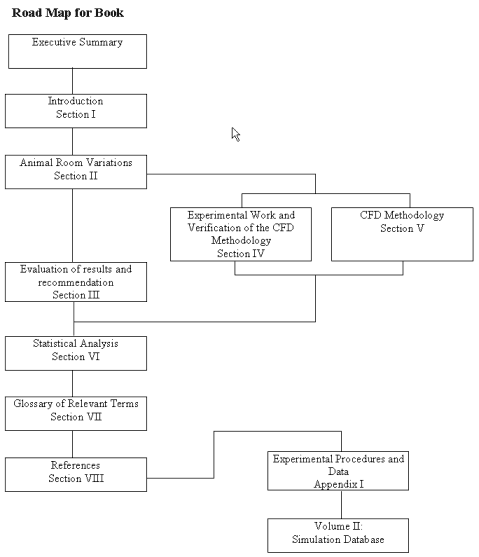Section I provides background information that will aid understanding of the project objectives and scope. This should be read by all. Section II Outlines the computational fluid dynamics (CFD) base line model, including such details as the physical geometry chosen, details of cages, racks, and change stations. This section also includes a table summarizing the description of 100 animal research facilities considered in this project. It outlines the different means of presenting the vast data generated. It offers explanations of a qualitative approach to visualizing the flow (vector plots, fill plots) and of the quantitative analysis parameters such as mean temperatures, CO2 and NH3 concentrations in the in the room and cage breathing zones. The results from the base line simulation are presented using these two approaches.
Section III Gives a graphical presentation of results for all 100 animal research facilities for mean room breathing zone temperature, mean cage temperature, mean room breathing zone relative humidity, mean cage relative humidity, room breathing zone CO2 concentration, and mean cage CO2 concentration. It also presents room breathing zone and mean cage NH3 concentrations on a given day within the 10-day cycle (day 4). The section includes conclusions and recommendations for the following: supply type and exhaust position; air change rate; change station design and status; pressurization of room relative to corridor; orientation of cage racks and rack groupings; density of cages; side cracks of cages sealed instead of open; room width; and supply temperature. Finally, this section presents NH3 levels in the cages and breathing zone for all the 100 animal research facilities over the 10 days of the cycle.
Section IV Contains experimental data and validation of the computational fluid dynamics methodology used in this project. This section identifies and explains the experimental tests and procedures for the cage conditions, CO2, NH3, H2O, and heat generation for mice. In this section the validation of CFD vs. experimental work as well as diffuser validation against manufacturer's data are presented.
Section V Provides an explanation of the methodology used. It provides a basis for those with no knowledge of computational fluid dynamics. Includes description of Navier-Stokes equations and boundary conditions used in this project.
Section VI : Describes a statistics overview and analysis of variance (ANOVA) techniques used for this project. ANOVA is a broad range of analytic techniques that address questions of statistical significance through calculation methods that divide overall variance into components.
Section VII Provides glossary of relevant CFD and experimental terms used in this project
Section VIII Complete listing of references
Appendix I Provides detailed information on the experimental procedures summarized in section 4 as well as full information on the raw data collected in these experiments.
Volume II presents two-page summary data for all 100 animal room simulations in the form of a picture of the case, a description, tabulated data, and histograms. Also included are a reprise of the description of the basecase room and the variations considered. Tables ranking the cases in ascending order on room and cage values of temperature, relative humidity, CO2, and NH3 concentration are also provided.
We recommend an HTML 2.0 compatible browser & a PDF helper application  to view these pages.
to view these pages.
